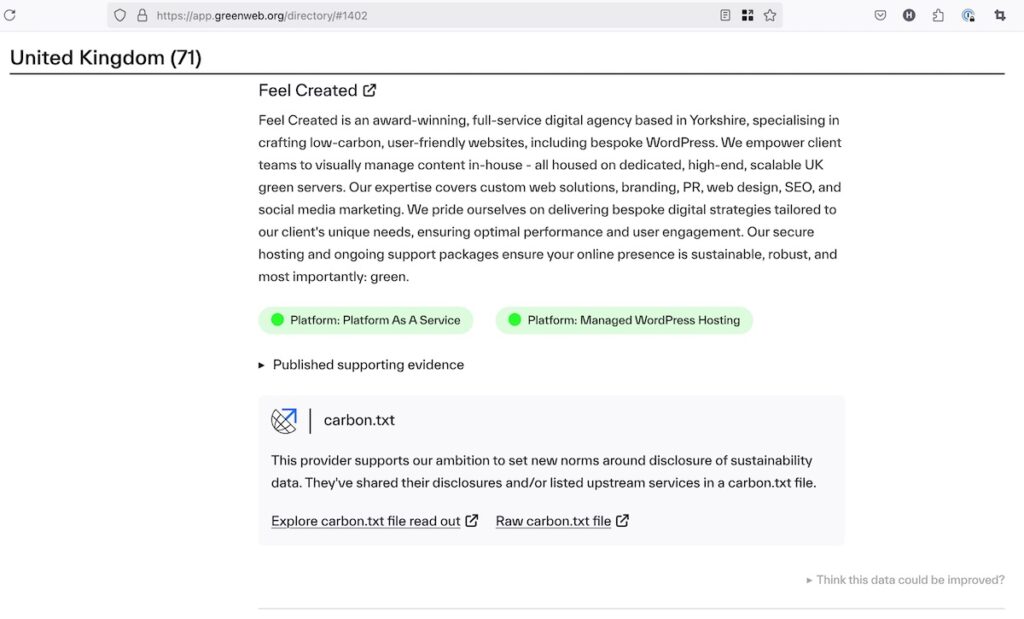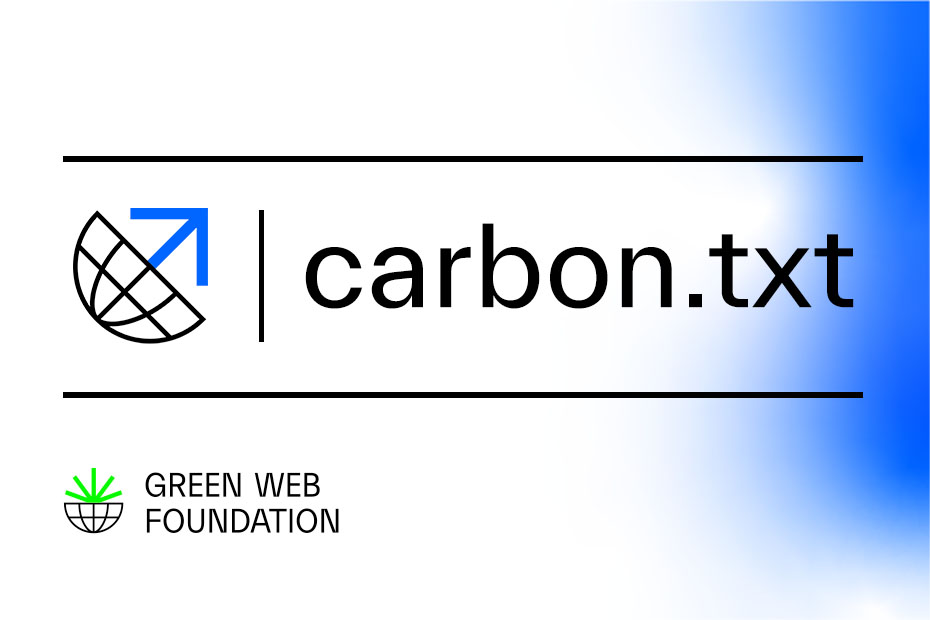In this post we explain how we’re using our latest project, carbon.txt, in combination with our Green Web Dataset. We cover why sharing evidence of green claims data inside a carbon.txt file has the potential to positively impact organisations disclosing data and the digital sustainability sector as a whole. We also provide practical advice on how to get started.
Organisations sharing their sustainability data via a carbon.txt file demonstrate a real commitment to sustainability through being transparent. This approach allows more ambitious players to set new norms around disclosure.

Chris Adams, Director of Policy & Tech – Green Web Foundation
Addressing sustainability problems with the Green Web Dataset
Since 2006, we’ve been independently verifying hosting providers to check they are running on green electricity. The data and evidence submitted by providers for the verification process forms a core part of the Green Web Dataset.
It’s become the world’s biggest open dataset of websites that run on green electricity. It enables the free, open source tools that we, and many others, build to measure and manage the environmental impact of digital services. Every day, across the globe, around seven million checks are made against the dataset by people wanting to answer the question “is this website hosted green?”.
One of our most popular tools references the dataset under the hood. Our Green Web Directory is a searchable list of verified green hosting providers found in the dataset, which enables people to quickly find sustainability conscious organisations they can buy services from.
What types of sustainability data are available via the Green Web Dataset?
The dataset contains data about verified green hosting providers such as:
- the evidence used to demonstrate they are running on green energy.
- which parts of that evidence can be disclosed publicly.
- when they joined the dataset and last refreshed their evidence.
- who their upstream green hosting provider is, if they use one.
- what IP or ASN numbers they operate green services on.
Our Provider Portal, sometimes referred to as the Green Web Platform, is the system used to streamline the process of collecting and managing this data behind the scenes.
Structured, machine-readable formats
Access to the dataset is provided by the Green Web API, which allows developers to query the dataset and get results as structured, machine-readable JSON data objects.
How the Green Web Dataset and carbon.txt are used together
The verification process through which hosting providers are listed in the Green Web Dataset now accepts the submission of evidence of green claims via a public carbon.txt file. The Green Web Directory profiles of verified green hosting providers who share evidence in this way are highlighted and the contents of their carbon.txt file made visible.
For any verified green hosting provider wishing to take full advantage of this, follow these steps:
- Create, validate and publish a carbon.txt file to share your public sustainability evidence using our tools.
- Log into your Green Web Provider Portal account.
- Find your provider listing, click the “Update Provider” button and follow the verification wizard to update your listing.
- When you reach “Step 4 – Submit your evidence”, use the form fields to link to your carbon.txt file.
- Submit the verification request for review & approval.
An example
Feel Created, a UK based hosting provider, are one of the first adopters of a carbon.txt file to share their sustainability evidence in this way. Their listing in our Directory looks like this:

View their Green Web Directory profile and associated carbon.txt file.
Getting started
Begin with small actions. It’s a great first step to link any existing sustainability data your organisation already has in a single, discoverable place using a carbon.txt file, even if the data within is not perfect or standardized. This is exactly what we did first our own GWF carbon.txt file!
Our carbon.txt builder helps anyone get started creating their first carbon.txt file, and our quickstart guide will take you through the process of creating and uploading your file for the first time.
If you are lost in the process and have questions, help is always available. Contact us!
Advice from a seasoned practitioner
We asked Fershad Irani, our Dataset Lead, what advice he’d give a green hosting provider who wants to create a carbon.txt file.
- Share more than just a web page – Having a sustainability or ESG page on your site is a great start, but by sharing more detail in your carbon.txt file you can help streamline the verification process. Some example of what you can add to your carbon.txt file include:
- Links to valid Renewable Energy Certificates (RECs)
- Links to valid Power Purchase Agreements or public contracts
- Links to sustainability reporting that show your use of 100% green energy
- Point to any upstream providers you might have – Using the upstream section of your carbon.txt file to link to any upstream providers you might have. For example, if you are an agency that uses Hetzner (an existing verified provider) to host all your client’s websites then you can use the upstream section of your carbon.txt file to show that connection. We can use that, along with other information shared in your verification request, to verify your provider listing based on those conditions.
You can continually update your carbon.txt file as your reporting or data standardisation processes mature – that’s the beauty of the web.

Fershad Irani – Green Web Dataset lead – Green Web Foundation
Looking forward to the benefits
Sharing evidence of green claims data inside a carbon.txt file has the potential to positively impact organisations disclosing data and the digital sustainability sector as a whole.
How do organisations using the Green Web Dataset and carbon.txt benefit?
Organisations sharing their sustainability data via a carbon.txt file demonstrate a real commitment to sustainability through being transparent, which in turn can positively benefit a brand’s trust. This approach allows more ambitious players to set new norms around disclosure.
How can the digital sector become more sustainable through this approach?
Improving the sustainability of digital services relies on timely access to relevant data to inform the decisions by people building systems or the organisations buying them.
When we move to a model where the default for data to support claims of sustainability is a single hyperlink away, it increases the number of actors who can review the data. It also creates upwards pressure on the quality of the disclosed information, because it makes poor disclosure more visible, especially when people try to use it.
Approaches like carbon.txt embed an expectation that anyone, anywhere should be able to independently verify claims made by companies because the supporting data is quick and easy to find. Instead of centralising trust to a single provider or auditor, it opens the door to an ecosystem approach. We also remove the risk of being reliant on a centralised data repository which can become a single point of failure.
Questions or need support?
If you need help making use of carbon.txt to share your sustainability data our dedicated carbon.txt website is there to help you get started.
If you can’t find what you’re looking for, or would like to explore a collaboration to build tools to scrape data disclosed in carbon.txt files, get in touch through our support form.

